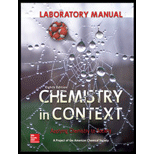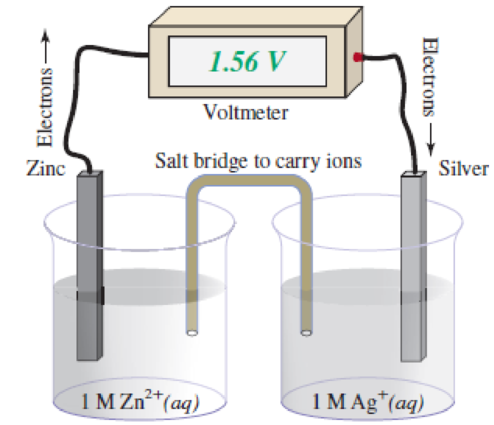
Laboratory Manual Chemistry in Context
8th Edition
ISBN: 9780073518121
Author: American Chemical Society
Publisher: McGraw-Hill Education
expand_more
expand_more
format_list_bulleted
Textbook Question
Chapter 8, Problem 6Q
Consider the galvanic cell pictured. A coating of impure silver metal begins to appear on the surface of the silver electrode as the cell discharges.

- a. Identify the anode and write the oxidation half-reaction.
- b. Identify the cathode and write the reduction half-reaction.
Expert Solution & Answer
Want to see the full answer?
Check out a sample textbook solution
Students have asked these similar questions
Highlight each glycosidic bond in the molecule below. Then answer the questions in the table under the drawing area.
HO-
HO-
-0
OH
OH
HO
NG
HO-
HO-
OH
OH
OH
OH
NG
OH
€
+
Suppose the molecule in the drawing area below were reacted with H₂ over a platinum catalyst. Edit the molecule to show what would happen to it. That is, turn
it into the product of the reaction.
Also, write the name of the product molecule under the drawing area.
Name: ☐
H
C=0
X
H-
OH
HO-
H
HO-
-H
CH₂OH
×
Draw the Haworth projection of the disaccharide made by joining D-glucose and D-mannose with a ẞ(1-4) glycosidic bond. If the disaccharide has more than
one anomer, you can draw any of them.
Click and drag to start drawing a
structure.
X
Chapter 8 Solutions
Laboratory Manual Chemistry in Context
Ch. 8.1 - Prob. 8.3YTCh. 8.1 - Prob. 8.4YTCh. 8.3 - Prob. 8.9CTCh. 8.4 - Prob. 8.10CTCh. 8.4 - Prob. 8.11SCCh. 8.5 - Prob. 8.13SCCh. 8.5 - Prob. 8.14CTCh. 8.6 - Prob. 8.16CTCh. 8.7 - Prob. 8.17CTCh. 8.7 - Prob. 8.18YT
Ch. 8.7 - Prob. 8.21CTCh. 8.8 - Prob. 8.23CTCh. 8 - Prob. 1QCh. 8 - Prob. 2QCh. 8 - Which chemical species gets oxidized and which...Ch. 8 - What is the difference between a galvanic cell and...Ch. 8 - Two common units associated with electricity are...Ch. 8 - Consider the galvanic cell pictured. A coating of...Ch. 8 - Prob. 7QCh. 8 - a. How does the voltage from a tiny AAA alkaline...Ch. 8 - Prob. 9QCh. 8 - The mercury battery has been used extensively in...Ch. 8 - Prob. 12QCh. 8 - During the conversion of O2(g) to H2O(l) in a fuel...Ch. 8 - How does the reaction between hydrogen and oxygen...Ch. 8 - This diagram represents the hydrogen fuel cell...Ch. 8 - What is a PEM fuel cell? How does it differ from...Ch. 8 - In addition to hydrogen, methane also has been...Ch. 8 - Prob. 18QCh. 8 - Potassium and lithium both are reactive Group 1...Ch. 8 - What challenges keep hydrogen fuel cells from...Ch. 8 - Every year, 5.6 1021 kJ of energy comes to Earth...Ch. 8 - Prob. 22QCh. 8 - Prob. 23QCh. 8 - Prob. 24QCh. 8 - Prob. 25QCh. 8 - Consider these three sources of light: a candle, a...Ch. 8 - Prob. 27QCh. 8 - What is the difference between an electrolytic...Ch. 8 - Provide some differences between a leadacid...Ch. 8 - Prob. 30QCh. 8 - The company ZPower is promoting its silverzinc...Ch. 8 - Prob. 32QCh. 8 - Prob. 33QCh. 8 - You never need to plug in Toyotas gasolinebattery...Ch. 8 - Prob. 35QCh. 8 - What is the tragedy of the commons? How does this...Ch. 8 - Hydrogen is considered an environmentally friendly...Ch. 8 - Fuel cells were invented in 1839 but never...Ch. 8 - Hydrogen and methane both can react with oxygen in...Ch. 8 - Engineers have developed a prototype fuel cell...Ch. 8 - How can the principles of green chemistry be...Ch. 8 - Prob. 42QCh. 8 - Prob. 43QCh. 8 - Small quantities of hydrogen gas can be prepared...Ch. 8 - Prob. 45QCh. 8 - Prob. 46QCh. 8 - Prob. 47QCh. 8 - Prob. 48QCh. 8 - Although Alessandro Volta is credited with the...Ch. 8 - Prob. 50QCh. 8 - If all of todays technology presently based on...Ch. 8 - Prob. 52QCh. 8 - Prob. 53QCh. 8 - Prob. 54QCh. 8 - Prob. 55Q
Knowledge Booster
Learn more about
Need a deep-dive on the concept behind this application? Look no further. Learn more about this topic, chemistry and related others by exploring similar questions and additional content below.Similar questions
- Epoxides can be opened in aqueous acid or aqueous base to produce diols (molecules with two OH groups). In this question, you'll explore the mechanism of epoxide opening in aqueous acid. 2nd attempt Be sure to show all four bonds at stereocenters using hash and wedge lines. 0 0 Draw curved arrows to show how the epoxide reacts with hydronium ion. 100 +1: 1st attempt Feedback Be sure to show all four bonds at stereocenters using hash and wedge lines. See Periodic Table See Hint H A 5 F F Hr See Periodic Table See Hintarrow_forward03 Question (1 point) For the reaction below, draw both of the major organic products. Be sure to consider stereochemistry. > 1. CH₂CH₂MgBr 2. H₂O 3rd attempt Draw all four bonds at chiral centers. Draw all stereoisomers formed. Draw the structures here. e 130 AN H See Periodic Table See Hint P C Brarrow_forwardYou may wish to address the following issues in your response if they are pertinent to the reaction(s) you propose to employ:1) Chemoselectivity (why this functional group and not another?) 2) Regioselectivity (why here and not there?) 3) Stereoselectivity (why this stereoisomer?) 4) Changes in oxidation state. Please make it in detail and draw it out too in what step what happens. Thank you for helping me!arrow_forward
- 1) Chemoselectivity (why this functional group and not another?) 2) Regioselectivity (why here and not there?) 3) Stereoselectivity (why this stereoisomer?) 4) Changes in oxidation state. Everything in detail and draw out and write it.arrow_forwardCalculating the pH at equivalence of a titration 3/5 Izabella A chemist titrates 120.0 mL of a 0.7191M dimethylamine ((CH3)2NH) solution with 0.5501 M HBr solution at 25 °C. Calculate the pH at equivalence. The pk of dimethylamine is 3.27. Round your answer to 2 decimal places. Note for advanced students: you may assume the total volume of the solution equals the initial volume plus the volume of HBr solution added. pH = ☐ ✓ 18 Ar Boarrow_forwardAlcohols can be synthesized using an acid-catalyzed hydration of an alkene. An alkene is combined with aqueous acid (e.. sulfuric acid in water). The reaction mechanism typically involves a carbocation intermediate. > 3rd attempt 3343 10 8 Draw arrows to show the reaction between the alkene and hydronium ion. that 2nd attempt Feedback 1st attempt تعمال Ju See Periodic Table See Hint F D Ju See Periodic Table See Hintarrow_forward
- Draw the simplified curved arrow mechanism for the reaction of acetone and CHgLi to give the major product. 4th attempt Π Draw the simplified curved arrow mechanism T 3rd attempt Feedback Ju See Periodic Table See Hint H -H H -I H F See Periodic Table See Hintarrow_forwardSelect the correct reagent to accomplish the first step of this reaction. Then draw a mechanism on the Grignard reagent using curved arrow notation to show how it is converted to the final product. 4th attempt Part 1 (0.5 point) Select the correct reagent to accomplish the first step of this reaction. Choose one: OA Mg in ethanol (EtOH) OB. 2 Li in THF O C. Li in THF D. Mg in THF O E Mg in H2O Part 2 (0.5 point) Br Part 1 Bri Mg CH B CH, 1 Draw intermediate here, but no arrows. © TE See Periodic Table See Hint See Hint ין Harrow_forwardSelect the product for the following reaction. HO HO PCC OH ○ OH O HO ○ HO HO HOarrow_forward
- 5:45 Х Select the final product for the following reaction sequence. O O 1. Mg. ether 2.D.Oarrow_forwardBased on the chart Two similarities between the molecule with alpha glycosidic linkages. Two similarities between the molecules with beta glycosidtic linkages. Two differences between the alpha and beta glycosidic linkages.arrow_forwardplease help fill in the tablearrow_forward
arrow_back_ios
SEE MORE QUESTIONS
arrow_forward_ios
Recommended textbooks for you
- Chemistry: Matter and ChangeChemistryISBN:9780078746376Author:Dinah Zike, Laurel Dingrando, Nicholas Hainen, Cheryl WistromPublisher:Glencoe/McGraw-Hill School Pub Co
 Introductory Chemistry: A FoundationChemistryISBN:9781285199030Author:Steven S. Zumdahl, Donald J. DeCostePublisher:Cengage Learning
Introductory Chemistry: A FoundationChemistryISBN:9781285199030Author:Steven S. Zumdahl, Donald J. DeCostePublisher:Cengage Learning World of Chemistry, 3rd editionChemistryISBN:9781133109655Author:Steven S. Zumdahl, Susan L. Zumdahl, Donald J. DeCostePublisher:Brooks / Cole / Cengage Learning
World of Chemistry, 3rd editionChemistryISBN:9781133109655Author:Steven S. Zumdahl, Susan L. Zumdahl, Donald J. DeCostePublisher:Brooks / Cole / Cengage Learning  ChemistryChemistryISBN:9781305957404Author:Steven S. Zumdahl, Susan A. Zumdahl, Donald J. DeCostePublisher:Cengage Learning
ChemistryChemistryISBN:9781305957404Author:Steven S. Zumdahl, Susan A. Zumdahl, Donald J. DeCostePublisher:Cengage Learning Chemistry: An Atoms First ApproachChemistryISBN:9781305079243Author:Steven S. Zumdahl, Susan A. ZumdahlPublisher:Cengage Learning
Chemistry: An Atoms First ApproachChemistryISBN:9781305079243Author:Steven S. Zumdahl, Susan A. ZumdahlPublisher:Cengage Learning

Chemistry: Matter and Change
Chemistry
ISBN:9780078746376
Author:Dinah Zike, Laurel Dingrando, Nicholas Hainen, Cheryl Wistrom
Publisher:Glencoe/McGraw-Hill School Pub Co

Introductory Chemistry: A Foundation
Chemistry
ISBN:9781285199030
Author:Steven S. Zumdahl, Donald J. DeCoste
Publisher:Cengage Learning

World of Chemistry, 3rd edition
Chemistry
ISBN:9781133109655
Author:Steven S. Zumdahl, Susan L. Zumdahl, Donald J. DeCoste
Publisher:Brooks / Cole / Cengage Learning

Chemistry
Chemistry
ISBN:9781305957404
Author:Steven S. Zumdahl, Susan A. Zumdahl, Donald J. DeCoste
Publisher:Cengage Learning

Chemistry: An Atoms First Approach
Chemistry
ISBN:9781305079243
Author:Steven S. Zumdahl, Susan A. Zumdahl
Publisher:Cengage Learning

Introduction to Electrochemistry; Author: Tyler DeWitt;https://www.youtube.com/watch?v=teTkvUtW4SA;License: Standard YouTube License, CC-BY